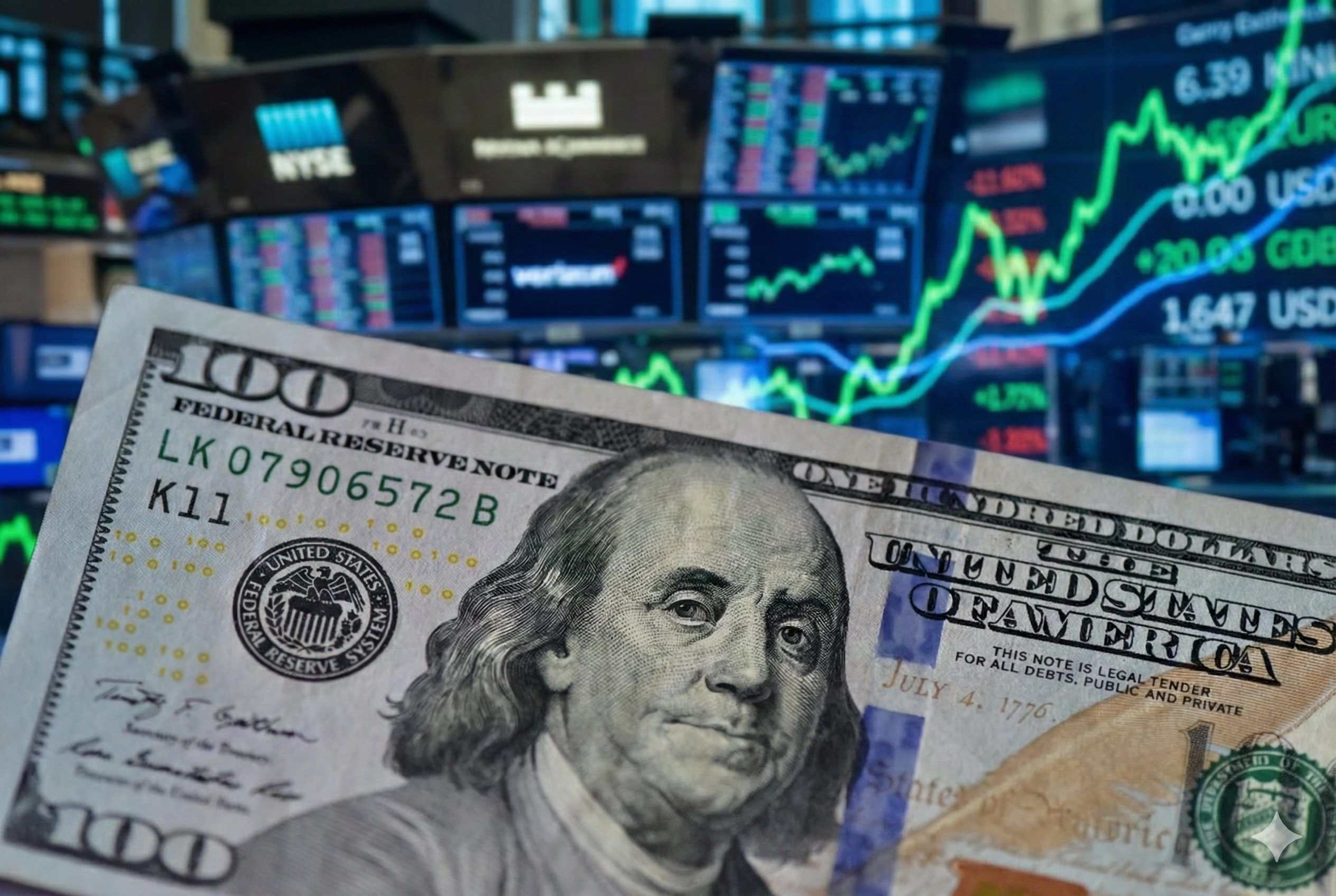The U.S. Dollar Index (DXY) finished Tuesday’s session under pressure, sliding back below the psychologically important 100 level as a batch of delayed U.S. economic data reinforced expectations that the Federal Reserve will cut interest rates in December.
By around 4:05 p.m. ET, the dollar index was hovering just under 100 near 99.8–99.9, down roughly 0.3–0.5% on the day, according to closing data from multiple providers. [1] That move extends a broader year‑on‑year decline of about 6–7%, even though the index is still up around 1% over the past month after briefly reclaiming the 100 handle. [2]
Key takeaways on the US Dollar Index today (25 November 2025)
- DXY closed below 100 around 99.8–99.9, down roughly 0.3–0.5% on the day, after trading between about 99.65 and 100.26. [3]
- Shutdown‑delayed U.S. data showed weaker‑than‑expected September retail sales (+0.2% vs ~0.3–0.4% consensus), soft core producer prices, and a sharp drop in November consumer confidence, fuelling concerns about late‑Q3 “stagflation‑lite.” [4]
- Fed doves and markets align: comments from Fed Governor Christopher Waller and NY Fed President John Williams, combined with today’s data, pushed the implied probability of a December 25 bp rate cut to roughly 80–83%. [5]
- EUR and GBP outperformed: the euro climbed about 0.5% to near $1.16 and sterling gained roughly 0.8% to trade above $1.32 as the greenback weakened across the majors. [6]
- Technical picture turned fragile: after spending recent sessions testing resistance above 100, DXY is now slipping below its 50‑day moving average around 99.8, with short‑term support eyed in the 99.0–98.8 area. [7]
- Next catalyst: Wednesday’s Fed Beige Book (2:00 p.m. ET) and upcoming delayed inflation and income data could either confirm or challenge the rapidly building rate‑cut narrative. [8]
US Dollar Index today: where DXY stands after the U.S. close
As of roughly half an hour after the New York equity close (around 4:30 p.m. ET), the U.S. Dollar Index is trading just under the 100 line following a clear intraday sell‑off.
- Intraday range: available futures and index data point to a high near 100.26 and a low around 99.65. [9]
- Close and daily change: several feeds show DXY ending the session near 99.85–99.86, down about 0.29–0.3% from Monday’s close. [10]
- Alternative snapshots: FX‑focused outlets and intraday commentary place the index fractionally lower intraday, with Reuters citing a 0.5% drop to about 99.75 and others flagging a mid‑day level near 99.78. [11]
The exact tick will vary by data vendor, but the story is consistent: the dollar index has clearly lost the 100 handle and is closing near the lows of the session.
At the same time, the 10‑year U.S. Treasury yield fell to roughly 4.01%, reflecting a broad rally in risk assets and rising confidence in the rate‑cut narrative. [12] U.S. equity benchmarks finished sharply higher for a second straight day, reinforcing the sense of a “risk‑on” reaction to softer data and easier‑policy hopes rather than a classic flight‑to‑safety dollar bid. [13]
Data deluge revives talk of “stagflation” and December cuts
Tuesday’s FX move was driven less by surprise headlines and more by a catch‑up in official data that had been delayed by an unusually long U.S. government shutdown earlier in the autumn. [14]
Retail sales and PPI: growth slower, inflation milder
The first key release was September retail sales, which rose just 0.2% month‑on‑month, missing economist forecasts of around 0.3–0.4% and slowing sharply from August’s 0.6% gain. [15]
On the inflation side, the Producer Price Index (PPI) increased 0.3%, broadly in line with expectations, but the core PPI measure rose only 0.1%, below consensus estimates of 0.2%. [16] Taken together, the data suggested slowing demand and still‑contained pipeline inflation, a combination that tends to:
- Undermine the case for keeping policy rates elevated, and
- Fuel investor debates about a “stagflation‑ish” Q3 backdrop – not a deep downturn, but softer growth with inflation not falling fast enough for comfort. [17]
Confidence collapses
Adding to the pressure on the dollar, U.S. consumer confidence plunged to 88.7 in November, down sharply from a revised 95.5 in October and well below expectations of around 93. [18] That’s the weakest reading since April and points to a household sector that is increasingly cautious about big‑ticket purchases and the 2026 outlook.
For FX traders, that mix of slower spending, softer core inflation, and deteriorating sentiment is the kind of backdrop that makes a December Fed rate cut feel less like a contingency and more like the base case.
Fed doves, futures markets and the December FOMC meeting
The data didn’t arrive in a vacuum. They landed on top of an already dovish stretch of Fed commentary and a markets community increasingly convinced that the hiking cycle is over.
In recent days:
- Fed Governor Christopher Waller said the labor market looks weak enough to support another 25‑bp cut in December, while keeping later decisions “data dependent.” [19]
- New York Fed President John Williams similarly flagged openness to further easing at the upcoming meeting. [20]
- San Francisco Fed President Mary Daly, cited in market commentary, has leaned toward a cautious, data‑driven path that markets interpret as dovish relative to earlier Fed rhetoric. [21]
Rate‑futures markets responded quickly:
- The CME FedWatch tool now implies roughly an 80–83% probability of a 25‑bp rate cut in December, up from about 50% a week ago. [22]
That repricing is central to today’s dollar story: as investors move to price lower yields sooner, the relative appeal of USD‑denominated assets declines, and the Dollar Index tends to drift lower unless there is offsetting geopolitical or risk‑aversion demand.
How major currency pairs traded against the dollar
The broad‑based nature of today’s dollar move is visible across major currency pairs.
Euro and pound lead gains
- The euro climbed about 0.5% to around $1.157–1.158, extending a recent rebound as traders embraced the idea of earlier Fed easing relative to the European Central Bank. [23]
- Sterling rallied roughly 0.8% to trade around $1.32, buoyed by both general dollar weakness and an ongoing unwind of previously bearish U.K. positioning. [24]
FX‑focused analysis notes that EUR/USD is testing resistance in the 1.1585–1.1600 zone, with a potential extension toward 1.17 if the breakout holds and U.S. data continue to underwhelm. [25]
Yen strengthens as yields slip
The Japanese yen firmed as U.S. yields dropped, with dollar/yen falling roughly 0.6% toward ¥156. [26] Given lingering concerns about potential Japanese intervention near recent highs, lower U.S. yields and a softer dollar provided the perfect excuse for traders to trim long USD/JPY positions.
Commodity and high‑beta FX
- GBP and EUR were the clearest winners today, but commodity‑linked currencies also reacted to shifting yield and risk dynamics. FX commentary highlighted a flat USD/CAD near 1.41 and a slightly weaker backdrop for other commodity currencies, even as the broader dollar slipped. [27]
- Emerging‑market currencies generally benefited from the softer dollar and improved risk sentiment, though the impact varied depending on domestic stories and sensitivity to U.S. growth. [28]
Technical picture: DXY loses the 100 handle again
From a chart perspective, today’s move looks like a rejection of resistance and a test of key moving averages rather than a complete trend reversal—at least for now.
100.00: from resistance to failed breakout
Ahead of today’s data, DXY had been hovering just above the 100 level, an area highlighted by technical analysts as a crucial psychological and structural barrier. A Monday note from OANDA’s MarketPulse pointed out: [29]
- The 100.00 area has capped the index several times in recent months.
- The daily chart has been threatening a double‑top pattern, hinting at a deeper pullback if bulls fail to “win” the 100 zone.
- The 200‑day moving average (200‑DMA) sits just below 100, acting as a dynamic support line.
Today’s fade back below 100 and toward the high‑99s confirms that the breakout has stalled, at least on a first attempt.
Short‑term levels: moving averages and support zones
Intraday analysis from FX desks suggests: [30]
- DXY is trying to hold around its 50‑day moving average, near 99.8.
- A clear break below that area would bring focus to a support band in the 99.0–98.8 region, a zone that has previously attracted dip‑buyers.
- On the topside, any rebound would need to reclaim and hold above 100.0–100.6 to neutralize the double‑top risk and reopen targets toward 102.
For traders, that sets up a simple but powerful map:
- Below ~99.8–99.0: risk grows for a deeper correction toward late‑summer lows.
- Back above 100.0–100.6: dollar bulls can argue this was just a one‑day data shock within a developing recovery trend.
Positioning: dollar sentiment was already bearish
One reason today’s drop hasn’t turned into a full‑scale rout is that bearish dollar positioning was already elevated coming into November.
A Reuters poll published earlier this month found that FX strategists expected traders to remain net short the U.S. dollar through November, anticipating further weakness over the coming months as markets priced several more rate cuts by end‑2026 on top of those already delivered. [31]
At the same time, some participants suggested that positioning was less extremely bearish than earlier in the year, with investors having used late‑summer dips to selectively rebuild dollar exposure. [32]
Today’s move therefore looks less like the start of a brand‑new dollar bear market and more like a re‑acceleration of an existing trend—one that had paused while traders waited for clearer data after the shutdown.
What’s next for the US Dollar Index?
With Tuesday’s data now digested and DXY sitting just under 100, attention turns quickly to the next set of catalysts that could either confirm or challenge the market’s new consensus.
1. Fed Beige Book (Wednesday, 26 November)
The Federal Reserve’s Beige Book, scheduled for release on Wednesday at 2:00 p.m. ET, takes on extra significance this time around. [33]
Because official data have been disrupted by the shutdown, the Fed has been leaning more heavily on anecdotal information about hiring, pricing and demand across its districts. A recent Boston Fed study highlighted how the Beige Book can improve recession forecasting compared with standard quantitative models, which makes tomorrow’s release a potential volatility trigger for the dollar. [34]
- If the Beige Book paints a picture of broad slowdown and easing price pressures, markets could double down on the December‑cut view and extend dollar losses.
- If conditions look more resilient or inflation anecdotes remain hot, some of today’s move could reverse as traders scale back aggressive easing bets.
2. Upcoming inflation and income data
Thanks to the compressed post‑shutdown schedule, markets still have key prints to digest in coming weeks, including September personal income and spending data (with the PCE price index), now slated for early December. [35]
PCE inflation is the Fed’s preferred gauge; if it echoes today’s relatively tame PPI core numbers, it could reinforce the idea that the Fed has room to cut without reigniting inflation—a combination that is typically negative for the dollar over the medium term.
3. Liquidity and seasonality around Thanksgiving
Historically, Thanksgiving week can bring patchy liquidity and unusual intraday swings in the dollar and major FX pairs. Analyst work on Thanksgiving seasonality suggests a mild tendency for the Dollar Index to underperform early in the week before sometimes stabilising into month‑end. [36]
With many institutional desks partially staffed over the holiday, any surprise macro headlines—on geopolitics, data, or Fed communication—could have an outsized impact on short‑term DXY moves.
Bottom line: DXY enters a “decisive period”
By the close of trading on 25 November 2025, the message from markets is clear:
- The U.S. dollar is finally reacting to a powerful combination of weaker growth signals, softening inflation at the margin, and increasingly dovish Fed expectations. [37]
- The break back below 100, after several failed attempts to establish a foothold above that level, shifts the technical balance modestly toward more downside in the near term. [38]
- Yet with positioning already skewed against the dollar, further declines may depend on whether upcoming Beige Book and inflation releases confirm today’s “stagflation‑lite” narrative or challenge it. [39]
For traders and investors, the takeaway heading into the holiday break is straightforward:
DXY is no longer coasting above 100—it’s back in a fragile, data‑dependent zone where every new report and every Fed remark can push it meaningfully higher or lower.
Staying flexible on time frame, respecting the 99–100 band as a key battle‑ground, and watching the Fed’s communication closely will be critical for navigating the U.S. Dollar Index through the rest of this pivotal week.
References
1. www.investopedia.com, 2. markets.chroniclejournal.com, 3. www.investopedia.com, 4. www.reuters.com, 5. www.reuters.com, 6. www.reuters.com, 7. www.fxempire.com, 8. www.federalreserve.gov, 9. www.investing.com, 10. www.investopedia.com, 11. www.reuters.com, 12. www.investopedia.com, 13. www.investopedia.com, 14. www.reuters.com, 15. www.reuters.com, 16. www.reuters.com, 17. www.reuters.com, 18. www.reuters.com, 19. www.reuters.com, 20. www.reuters.com, 21. markets.chroniclejournal.com, 22. www.reuters.com, 23. www.reuters.com, 24. www.reuters.com, 25. www.fxempire.com, 26. www.reuters.com, 27. www.fxempire.com, 28. markets.chroniclejournal.com, 29. www.marketpulse.com, 30. www.fxempire.com, 31. www.reuters.com, 32. www.reuters.com, 33. www.federalreserve.gov, 34. papers.ssrn.com, 35. www.wsj.com, 36. www.forex.com, 37. www.reuters.com, 38. www.marketpulse.com, 39. www.reuters.com










